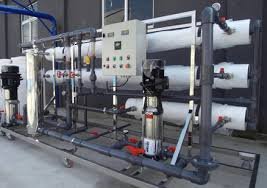Biofilm Removal and Chemical Sanitization of RO Systems

Biofilm Removal and Chemical Sanitization of RO Systems
1. Introduction
RO membranes in pharmaceutical water systems (Purified Water / WFI) are prone to biofilm formation due to microbial contamination and nutrient accumulation.
-
Biofilm is a slimy matrix of microorganisms, polysaccharides, and proteins attached to membrane surfaces.
-
Once formed, biofilms reduce RO efficiency, increase pressure drop, reduce permeate quality, and may lead to microbial excursions.
2. Biofilm Removal
Biofilms cannot be removed by plain flushing — they require chemical cleaning.
Steps for Biofilm Removal
-
Initial Flush: Flush system with permeate water to remove loose debris.
-
Chemical Circulation: Circulate cleaning solution (alkaline/acid/biocidal) through the RO at low pressure to avoid damaging membranes.
-
Soaking Period: Allow soaking (30–60 minutes) for the chemicals to penetrate biofilm.
-
Recirculation: Resume circulation to detach and dissolve biofilm residues.
-
Rinsing: Thoroughly rinse with purified/deionized water until neutral pH is achieved.
-
Microbial Verification: Test permeate and reject streams for microbial count before resuming service.
3. Chemical Sanitization
RO systems are sanitized periodically to control microbial growth and prevent biofilm reformation.
Common Sanitizing Agents
-
Sodium hypochlorite (NaOCl): Effective oxidizer but damages polyamide RO membranes → only used upstream or for non-PA membranes.
-
Peracetic acid (PAA): Strong oxidizing biocide, compatible with RO membranes, effective against spores and biofilm.
-
Hydrogen peroxide (H₂O₂): Strong oxidizer, can be used in combination with PAA.
-
Citric acid / phosphoric acid: Used to remove scale and as part of cleaning cycle.
-
Hot water sanitization (≥80 °C): Preferred for heat-tolerant RO membranes (pharma-grade membranes).
4. Best Practices for Efficiency
-
Alternating chemicals: Use both alkaline and acidic cleaners to remove organic and inorganic fouling.
-
PAA/H₂O₂ cycles: Effective for biofilm control while being membrane-compatible.
-
Cleaning frequency: Based on pressure drop, salt rejection %, or microbial counts.
-
Monitoring: Differential pressure, conductivity, TOC, and microbial levels indicate cleaning need.
-
Sanitization schedule: Routine sanitization (weekly/biweekly) to prevent biofilm recurrence.
-
Validation: Document cleaning effectiveness with microbial and TOC reduction studies.
5. Documentation
-
Sanitization protocol with chemical concentrations, contact times, and safety precautions.
-
Logs of cleaning frequency, agent used, exposure time, and rinse verification.
-
Microbiological and TOC test results before and after cleaning.
-
QA approval of cleaning/sanitization reports.
✅ In short:
Biofilm removal in RO systems requires specialized cleaning chemicals (alkaline, acidic, oxidizing) followed by chemical sanitization (PAA, H₂O₂, or hot water). Routine monitoring and validated cleaning cycles are critical for ensuring consistent pharmaceutical water quality.
🎓 Discover one of the best Pharmaceutical Microbiology course available —click below to explore the course that’s shaping future Microbiology course skills.

